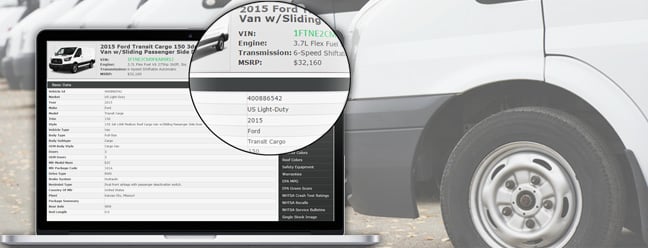You've built a solution that helps many companies better manage their fleet. Your customers can easily keep up with their vehicle maintenance, title renewals, and insurance policies -- among other tasks. They are even finding ways to increase fuel efficiency with your telematics reporting feature. So what else does your software need?
There are always more problems we can help our customers or potential customers solve. And the end user appreciates when their solution providers continually look for ways to make their products even better.
So how does a VIN decoder help improve your fleet management software? In this article, I've noted four major benefits that a VIN decoder will offer.
1. Quicker access to vehicle info
Who doesn't prefer a user interface with a quick search feature? In this case, it would be quick access to vehicle info by VIN.
Some of these VIN searches performed by your customers may be for referencing current vehicles to spec' out their next vehicles, accessing maintenance history of a particular vehicle, or determining which drivers are assigned to a certain vehicle. Having a VIN decoder option would be especially beneficial for companies that are managing a fleet of hundreds or even thousands of vehicles.
Since a VIN is unique to each vehicle, searching by VIN will give your customers the single search result they're looking for.
2. No more manually adding new vehicles
Tracking down all of the details and specs for each vehicle and manually plugging them into a fleet management system is less than ideal for a couple reasons:
- Finding certain vehicle information can be a bit challenging without OEM connections.
- Manually plugging in all that information is time-consuming and leaves room for error.
Adding a VIN decoder to your solution will allow users to simply plug in the VIN and let the vehicle database populate all the fields for them. This is a great way to save time for your customers while ensuring vehicle description accuracy for their fleet moving forward.
3. Bulk vehicle uploads
There will certainly be times when your customers will want to upload or update multiple vehicles in the fleet management system at the same time. Depending on the size of the list, adding each vehicle individually can take hours, even when the vehicle details and specs are populated by VIN
Fortunately, most VIN decoders can support bulk decoding, which would eliminate the need to plug in one VIN at a time. The amount of VINs that can be decoded per request may vary by vehicle data providers. DataOne offers up to 50 VINs in a single request to the web service.
4. Cleansing of existing vehicle details & specs
Your customers have done their best to obtain as much vehicle data on their fleet as possible in the past, but yet there are still some blank fields, inconsistent vehicle descriptions, or discrepancies in data. However, a VIN decoding solution provider is working with vehicle data all day every day, and has connections with all the OEMs to ensure the most complete and accurate data.
Offering a VIN decoder in your software is a great way for your customers to cleanse their current fleet's vehicle details and specs, fill in some of those empty fields and normalize all of their existing descriptions.
Conclusion
Implementing a VIN decoding solution into your software is a simple addition that will really add a ton of value for the users. Your customers will be happy to improve their business processes and prospects are more likely to close with the added benefits to your solution. It's a win-win situation.

